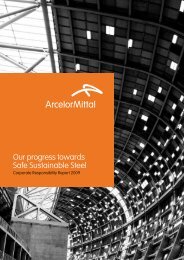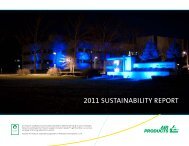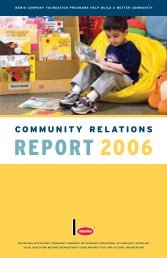Sustainability Report - Dell
Sustainability Report - Dell
Sustainability Report - Dell
Create successful ePaper yourself
Turn your PDF publications into a flip-book with our unique Google optimized e-Paper software.
Packaging Project: Slip SheetsDuring fiscal year 2005, <strong>Dell</strong> implemented slip sheets(a three-pound, .03-inch thick plastic sheet) instead of woodpallets (which weighed 40 pounds and were 5 inches tall)for inbound chassis products, which resulted in more than8,000 tons of wood reduction for inbound shipments. In fiscalyear 2006, the program was expanded to include monitors andflat panels, which resulted in over 17,000 tons of wood savedannually, a greater than 50 percent increase in savings from theprevious year. The freight density is also increased, whichresults in less truck shipments, less fuel used, and therefore,less emissions to the environment.Fiscal Year 2006 Packaging Results and Fiscal Year 2007 GoalsIn fiscal year 2006, <strong>Dell</strong> saved over 24,000 tons of packagingmaterial by annual reduction and elimination of corrugated,plastic foam, and wood materials. The slip sheet projectaccounted for over 17,000 tons of the total tonnage reduction.For all other packaging materials used for inbound andoutbound shipments, the fiscal year 2006 goal of reducingpackaging used by 5,000 tons was exceeded by more than2,000 tons, for a total of more than 7,000 tons of packagingmaterial avoided. The Worldwide Packaging Engineeringteam has set a dematerialization goal of 5,000 tons annuallyfor fiscal year 2007. The team will no longer track slip-sheetwood reduction because the project is fully implemented andis standard procedure at <strong>Dell</strong>. Our efforts will continue to saveat least 17,000 tons of wood annually.Reducing Paper Use with the Forest ProductsStewardship ModelIn fiscal year 2005, <strong>Dell</strong> developed a Forest ProductsStewardship Model that allowed us to review current practices,address topics within the paper industry that are important to<strong>Dell</strong>, and establish goals with respect to certain paper productsthat <strong>Dell</strong> uses, purchases and distributes.The first steps in the process included researching and openingdialogue with other companies that distribute similar productssuch as shipping cartons and catalogs. In addition, <strong>Dell</strong> communicatedwith external stakeholders in order to educate ourselvesabout various topics of interest within the paper industry.Finally, to further refine the model, we discussed it with membersof the paper supply chain to gather their invaluable input.Briefly, <strong>Dell</strong>'s model seeks to optimize quality, cost and environmentalattributes in our paper selection process for catalogs,ForestEthics Applauds <strong>Dell</strong>'s Environmental Standards"The fact that <strong>Dell</strong> has exceeded its original environmentalgoals is proof positive that when a companychooses to focus on the environment, it can have a realimpact. We applaud <strong>Dell</strong>'s leadership example and thecollaborative process that the company has taken indeveloping its environmental standards."<strong>Dell</strong> is that rare example of a company that understandshow important forests are, sets high standards,and then exceeds them—their work to transform theircatalogs is leading that industry and demonstratingwhat is possible."Todd PagliaExecutive Director of ForestEthicspackaging and office paper. Within that model, we will review,seek to produce results, and further our understanding in threekey areas: protecting endangered forests, improving forestpractices, and reducing demand on forests.Fiscal Year 2006 Progress toward GoalsDuring fiscal year 2006, <strong>Dell</strong> continued to engage with variousstakeholder groups regarding paper consumption. We workedwith paper manufacturers to ensure that demand and supply formodel-compliant papers can be balanced as <strong>Dell</strong>'s goals forrecycled content and certified fiber increase. As different businessunits within <strong>Dell</strong> realized the quality and success of ourfirst catalogs with 90 percent recycled content, the demand tomove more of our paper products to this content increased globally.This has provided both a challenge and an opportunity for<strong>Dell</strong> to expand our Forest Products Stewardship Model globallyand identify quality paper sources that meet our requirements.The following information lists <strong>Dell</strong>'s goals for reducing paperuse during fiscal year 2006, in addition to our attainment ofthese goals:• Goal: During 2005, obtain 5 percent of <strong>Dell</strong>'s catalog fiberfrom Forest Stewardship Council (FSC)-certified sources.Results: Approximately 13 percent of catalog and insertswere sourced from FSC-certified sources.• Goal: Achieve 10 percent post-consumer recycled contentin our catalogs by October 2005.Results: An average of approximately 17 percent wasachieved in fiscal year 2006.D E L L S U S T A I N A B I L I T Y R E P O R T • F I S C A L Y E A R 2 0 0 655
















